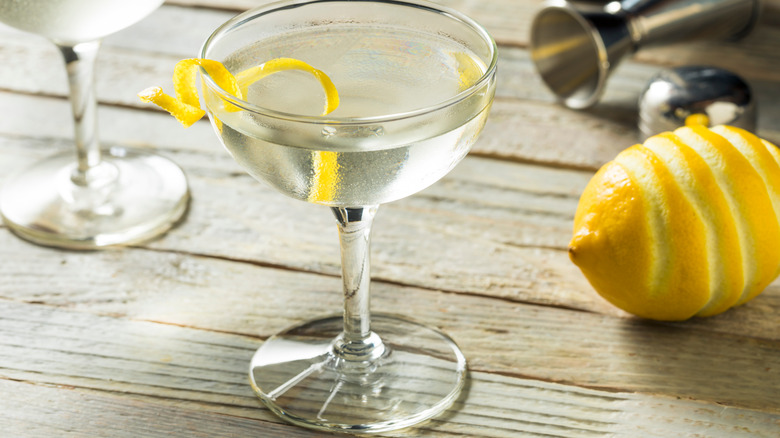What Does It Mean To Take A Martini Wet?
Just because classic cocktails rely on simple ingredients and straightforward recipes does not mean that you can't tailor them to your own tastes. By using different proportions of vodka or gin and dry vermouth — plus optional olive juice to make an extra-dirty or filthy martini — you (or your bartender) can create all sorts of variations. However, it is helpful to know the right lingo, and ordering a 'wet' martini is one such example.
If you like the taste of the vermouth to be more prominent, then you should take your martini wet. It uses two parts of gin or vodka to one part vermouth, which is much more vermouth than a martini usually includes. Just like all martinis, a wet martini is served straight up, meaning that all the ingredients are shaken or, more commonly, stirred, with ice. The result is a cocktail that is boozy but smooth, slightly less alcoholic, and leans on the herbal, floral, and bright aromas that dry vermouth is known for.
What is vermouth?
Vermouth is a type of fortified wine made with botanical ingredients that impart intriguing aromas and complexity of flavor. It starts with a grape wine base and then has a spirit added to it. Vermouth can be white, red, or somewhere in between and ranges from dry to sweet. Light-bodied dry vermouth brings an acidic and herbaceous quality to your favorite martini preparation. It is also used to add depth to lots of bright and refreshing cocktails, sipped on its own over ice with a twist, or even used like a dry white wine in dishes such as risotto and seafood pasta. On the other hand, sweet vermouth is rich, slightly viscous, and warmly spiced with a bittersweet flavor. It is a signature ingredient in Manhattans and Negronis.
If you are all about what vermouth brings to the table, give a perfect martini a try — it uses the same ratio as a wet martini but incorporates half-sweet and half-dry vermouths. You can even take it one step further and get a 50/50 martini, which has equal parts gin or vodka and vermouth.
What does it mean to take a martini dry?
If you can order a wet martini, it tracks that you can also order it dry. Taking a martini dry means that it has a greater ratio of gin or vodka to vermouth. A dry martini typically has between five and eight parts of gin or vodka to one part vermouth. Extra-dry has even less in the mix and sometimes the bartender will swirl only a touch of vermouth in the glass. Bone-dry will likely just be a glass of ice-cold vodka or gin with a lemon twist or olive skewer.
Even if you've never asked for a martini in this way, you probably already know what it tastes like. That's because, over time, the go-to recipes for martinis have become dryer. The earliest versions of a martini were what would now be considered wet, and they even typically had a couple of dashes of orange bitters to amplify the citrus notes of the gin and vermouth. As time progressed, the public grew to favor spirit-forward martinis, and the amount of vermouth commonly used has decreased.
These days, the ratios bars and restaurants use can vary widely. Knowing the terminology is helpful, but every place is going to make a very different cocktail even if you ask for a standard modifier, like wet or dry. This does give you a pretty darn good reason to sample as many martinis as possible — or devote some time to perfecting your own recipe!



